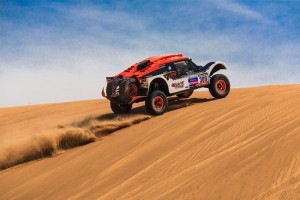Dakar Rally 2017
January 17, 2017
On Saturday, January 14, weary and filthy racers from all over the world pulled their off-road vehicles onto the streets of Buenos Aires, the capital of Argentina, completing the final stage of the Dakar Rally. The racers entered the city and crossed the finish line after 12 grueling days of gritty cross-country racing, covering 5,457 miles (8,782 kilometers) of dirt, rock, and sand. The race began in Asunción, Paraguay, on January 2, running north into Bolivia before winding back south to Argentina.

An off-road racer climbs the desert dunes near Ica, Peru, during the 2013 Dakar Rally. Credit: © Christian Vinces, Shutterstock
The Dakar Rally, once known as the Paris-Dakar Rally, is an annual cross-country endurance race. The rally includes five different vehicle categories: cars, motorcycles, quads (all-terrain vehicles, or ATV’s), trucks, and—new this year—utility task vehicles, or UTV’s (a two-seater style of ATV). The first Dakar Rally began on Dec. 26, 1978, as 182 motorcycles and cars revved their engines on the Place du Trocadéro in Paris, France, preparing for the 6,200-mile (10,000-kilometre) journey to Dakar, the capital of Senegal. Covering more than 500 miles (800 kilometers) per day, the winning racers crossed the Dakar finish line on Jan. 14, 1979 (just 74 vehicles completed the race). The racers followed a route from Paris to Marseille, where boats carried them across the Mediterranean Sea to Algeria. From there, the route continued through the dunes and dust of Niger, Mali, Upper Volta (now Burkina Faso), and, finally, Senegal.
The Dakar Rally continued annually and gained popularity, reaching a peak of 688 racers in 2005. In 2008, security threats in Mauritania (Mali’s neighbor to the west) shut down the race, and it was moved to the deserts and scrubland of South America. The 2017 Dakar Rally began with 566 racers. The winning drivers came from Brazil, France, Russia, and the United Kingdom.
To compensate for negative impacts of the race on the environment, Dakar Rally sponsors donate large sums to the Madre de Dios project that works to protect the Amazon rain forest and other natural habitats of South America. Race routes avoid sensitive archaeological or paleontological sites, and strict cleanup and recycling rules ensure the integrity of the stunning natural landscapes that define the spectacle of the rally.


